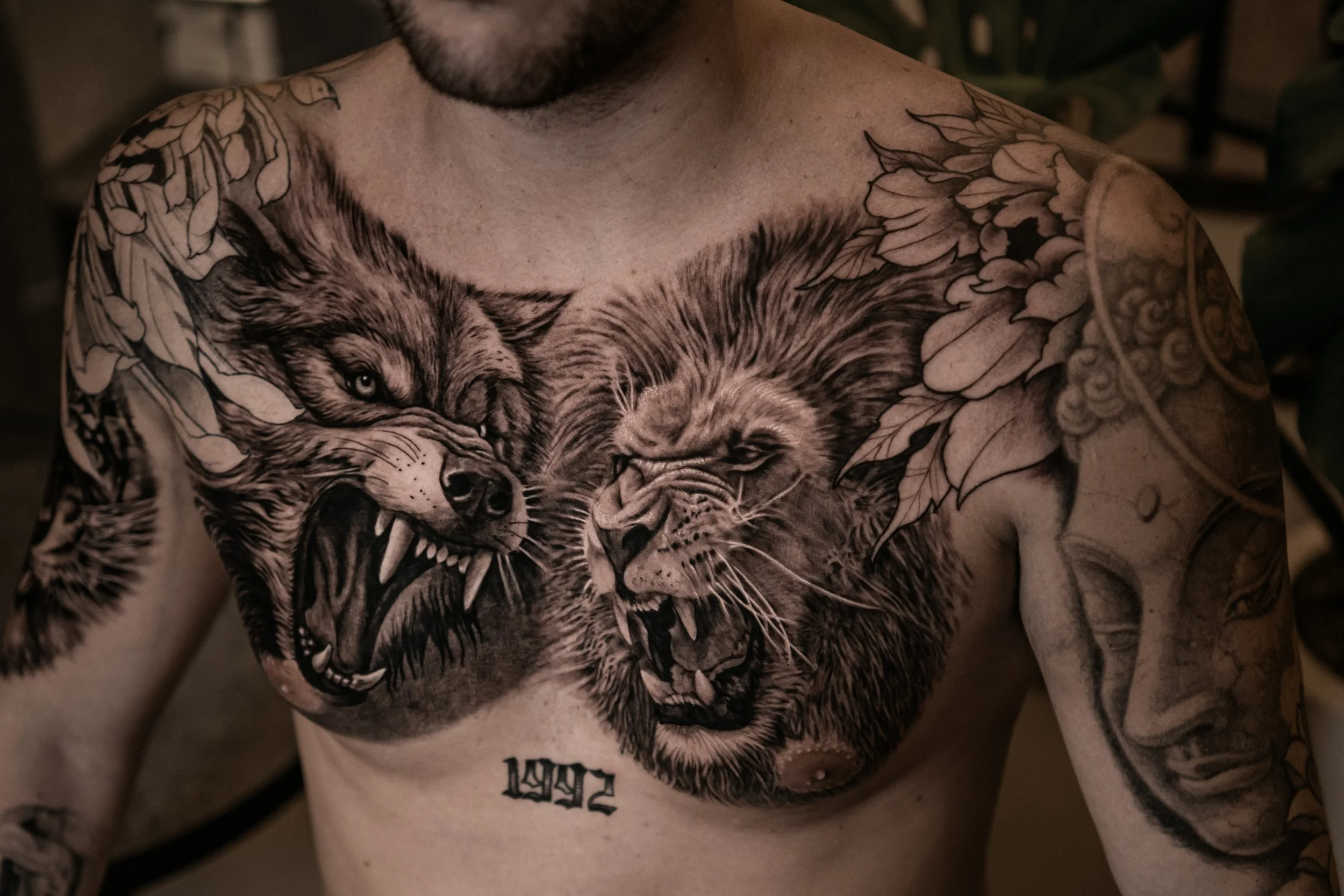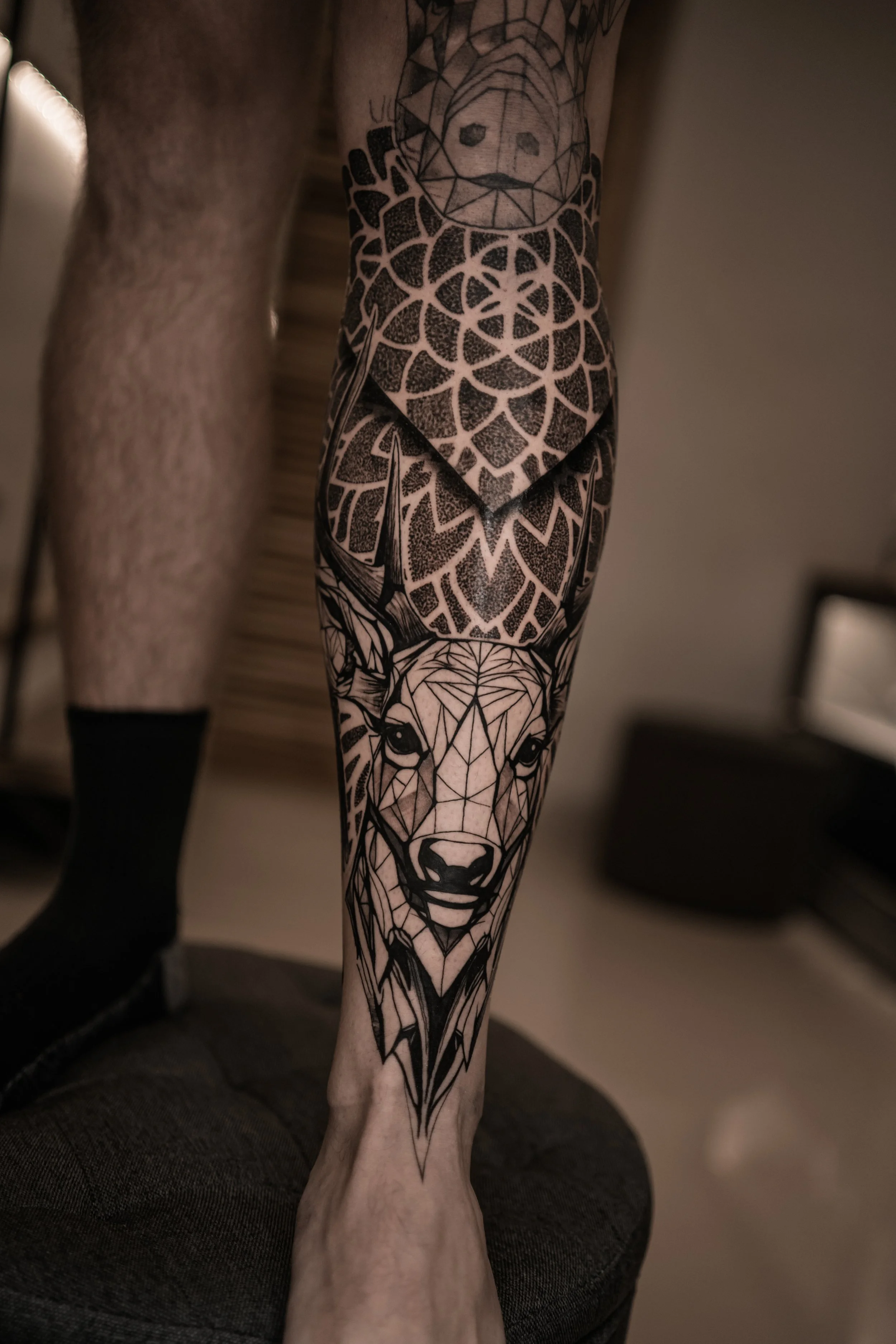Tattoo Aftercare; What's the best way to care for your new tattoo?
So you've got a new tattoo and are wondering how to take care of it. Or maybe you've gotten one recently and need a quick reminder. We'll explain the aftercare and healing process of your new tattoo. So you'll be able to take care of your tattoo during its most vulnerable stage, and further in the years to come.
Stage 1 - Freshly Done
This stage is the starting point for the aftercare of any tattoo. The tattoo is just complete and you're just coming down from the light (or heavy) session of tattooing. This is the point is when we would consider the tattoo most vulnerable. This is because your tattoo is effectively an open wound. Your skin is wounded from the tattoo needle penetrating it constantly. You should be extremely careful when it comes to handling your tattoo. Washing your hands before touching your tattoo will be important for both hygiene and the quality of your tattoo.
Your tattoo will be wrapped with plastic wrap, a medical pad, or a type of tattoo bandage such as Saniderm that will protect your tattoo for the next hours or even days. The purpose of the wrap is to keep out dust and any contaminants as the tattoo is still bleeding. This will keep in covered and allow your white blood cells and platelets to close the wounds. The amount of time you would leave the wrap on would depend on the type of wrap used:
Plastic wrap is generally left on for about an hour or two. This is meant to keep you covered until your reach home. Plastic wraps aren't meant to be left on long as they will suffocate the skin. Your body heat will lead to sweating inside the wrap, making it hard for the tattoo.
Medical pads can be left on for about 2 - 3 hours. The benefit of the medical pad is that they absorb any excess blood. If you find the medical pad has stuck to your tattoo. A good trick is to wet the tattoo and the pad with lukewarm water to loosen it.
Tattoo bandages such as Saniderm or other name brands are clear adhesive bandages meant to stay on for 1 - 4 days (Depending on the product. The reasoning is that they allow your tattoo to develop its protective scab layer. They are not only dustproof but also waterproof making them much safer. Although one quirk is that you may notice fluid pooling inside. Don't worry as this is normal, and is your excess blood from the healing process.
Once it's time to peel the wrap, be sure to wash your hands. Again, only touch your tattoo with clean hands. Slowly peel the bandage off. Once the bandage is off, dispose of it and then you can move to clean your tattoo. There are multiple ways to clean your tattoo:
You can rinse your tattoo with regular water. This would be easier for you as you can use bottled water, or even the shower. If you have a tattoo-safe soap. Using it will great to help properly clean your tattoo from any contaminants and bacteria. Be sure not to use hot water, as your skin will be really sensitive. Aside from the pain, the hot water will open up your skin's pores and can cause more blood and ink to come out (This is the case with fresh tattoos 1 - 2 hours post-tattooing).
If you are on the move or want to clean your tattoo while out of the house. Non-alcohol baby wet wipes are a great option. They have antibacterial properties and also allow you to clean your tattoo quickly without making a mess.
Be sure to clean your tattoo properly. As any excess blood will cause your tattoo's scab to be uneven and this can make healing trickier later on. Once you have cleaned your tattoo, pat it dry with a clean towel or tissue and let it dry.
During this time, please avoid direct sunlight, heavy exercise, dirt, and dust, and going swimming and soaking your tattoo. These will not only risk damaging your tattoo. But also can cause an infection. An infected tattoo would have these symptoms:
Itchiness, red spots, and bumps around/on your tattoo.
Increased swelling.
Oozing puss.
Fever symptoms such as shakings, chills, and sweating.
Be on the lookout for these symptoms. Although, if you've done your due diligence in looking for a hygienic studio and artist. This is something you wouldn't need to greatly worry about. As long as you keep proper hygiene in mind.
Wait till the scab layer of your tattoo has formed before moving on to the next step of aftercare.
Step 2 - Scabbing and Peeling
With the most critical part of the tattoo aftercare past, there's still a while left to go. With the scab layer of the tattoo formed, your tattoo will start to dry. While this is good, it is also not ideal. Dry tattoo scabs are bad, as they risk cracking, which can open up the wound. This can affect the result of your tattoo and prolong the healing process. That is why aftercare products are important. As they moisturize your tattoo for the whole day and night. Apply a thin layer of your aftercare product on the tattoo 10 minutes after cleaning your tattoo to make sure no water or extra moisture is trapped.
During this stage of healing, your tattoo will start to peel. The rough part of this stage is the itchiness. Naturally, your instinct is to scratch the itchy spots. DO NOT SCRATCH YOUR TATTOO! PLEASE DO NOT SCRATCH IT! This is important as scratching, or even picking away at scabs can cause the ink to fall out and also prolong healing. Aftercare products can help take the edge off of the itchiness, although in dire cases you can tap the spots with your fingers for some relief. Your scabs should fall off like dandruff flakes. You should still avoid the sun and soaking your tattoo during this stage. Once your scabs have fully peeled, you're getting close to the tattoo fully healing.
Stage 3 - Maintenance and Long-Term Care
Once your scabs have fully peeled, you'll notice that your tattoo looks marbled and faded. This is because the deeper layers of your skin are still healing. This will take a bit more time for the colors to truly show. During this stage, you would need to worry about soaking your tattoo, although the sun will still be your enemy. Be sure to use sunscreen and moisturizing cream to keep your tattoo moist and prevent any sunburn. Your tattoo will be fully healed once it looks close to its fresh appearance.
For long-term care, we would recommend regularly applying lotion and using sunscreen when going out. This would keep your tattoo lasting much longer and looking good as time goes on. If you want to keep your tattoo looking fresh down the line, or notice some missing spots. You can contact the artist about getting a touch-up done. At the end of the day, your tattoo is a part of you. Keeping it looking good takes time and care.
Conclusion
Those are the important things to note about tattoo aftercare. While it's a lot to take in at first (especially if it's your first tattoo). It'll get easier with the more tattoos you get. At the end of the healing, your caution and care will be worth it once your tattoo heals perfectly. Want to learn more about tattoos and the process? Read through more of our blogs! If you’re interested in getting a tattoo for yourself. Reach out to us! We’ll be happy to help you get an artist suitable for your design!




